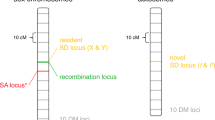Abstract
The population behavior of a gametophytic factor (Ga) which involves gametic selection due to failure ofga pollen onGa Ga orGa ga styles in competition withGa pollen, was investigated by computer simulation. A constant versus randomly varying gametic selection parameter (k) and four different schemes of zygotic selection were introduced in this model for analyzing conditions favorable for the maintenance of locusGa polymorphic in a large, mixed selfing and random mating population. Stable polymorphism was obtained only with rather substantial heterozygote advantage at locusGa whereas the opposing pressures of gametic and zygotic selection yielded fixation of alleleGa orga around a critical value of k instead of a range of k-values allowing nontrivial equilibria. With weak selection and stochastic k, however, very slow rates of change in the genotypic proportions allowed transient polymorphism. In these cases, the rate of outcrossing (t) and the initial frequency ofGa were critical in determining the rate of allelic substitution. Moreover, low values of t allowed the replacement of alleleGa byga even with rather weak zygotic selection. These findings on the balance between gametic and zygotic selection and a markedly frequency-dependent process are briefly discussed in relation to the dynamics of similar factors involving the mating system.
Similar content being viewed by others
References
Allard, R. W. (1963). An additional gametophyte factor in the lima bean.Der Züchter 33: 212–216.
Brown, S. W. (1964). Automatic frequency response in the evolution of male haploidy and other coccid chromosome systems.Genetics 49: 797–817.
Crosby, J. L. (1949). Selection of an unfavourable gene complex.Evolution 3: 212–230.
East, E. M. (1929). Self-sterility.Bibliogr. Genetica 5: 331–368.
East, E. M. &A. J. Mangelsdorf (1926). Studies on self-sterility. VII. Heredity and selective pollen-tube growth.Genetics 11: 466–481.
Finney, D. J. (1952). The equilibrium of a self-incompatible polymorphic species.Genetica 26: 33–64.
Fisher, R. A. (1941). Average excess and average effect of a gene substitution.Ann. Eugen. 11: 31–38.
Fraser, A., D. Burnell &D. Miller (1966). Simulation of genetic systems. X. Inversion polymorphism.J. Theor. Biol. 13: 1–14.
Jain, S. K. Gametic Selection.Adv. Genetics (in press).
Jain, S. K. &R. W. Allard (1966). The effects of linkage, epistasis, and inbreeding on population changes under selection.Genetics 53: 633–659.
Jones, D. F. (1928). Selective fertilization. Univ. of Chicago Press, Chicago. pp. 163.
Kimura, M. (1956). A model of a genetic system which leads to closer linkage by natural selection.Evolution 10: 278–287.
Kimura, M. (1964). Diffusion models in population genetics. Methuen, London. pp. 57.
Lewontin, R. C. &L. C. Dunn (1960). The evolutionary dunamics of a polymorphism in the house mouse.Genetics 45: 705–722.
Mangelsdorf, P. C. &D. F. Jones (1926). The expression of Mendelian factors in the gametophyte of maize.Genetics 11: 423–455.
Moran, P. A. P. (1962). The statistical processes of evolutionary theory. Clarendon Press, Oxford. pp. 200.
Nasrallah, M. E. &D. H. Wallace (1966). Immunochemical detection of incompatibility antigens in stigmas of self-incompatible and selffertile inbreds ofBrassica oleracea var. capitata.Genetics 54: 351.
Nelson, O. E. (1952). Nonreciprocal cross-sterility in maize.Genetics 37: 101–124.
Novitski, E. &E. R. Dempster (1958). An analysis of data from laboratory populations ofDrosophila melanogaster.Genetics 43: 470–479.
Rick, C. M. (1966). Abortion of male and female gametes in the tomato determined by allelic interaction.Genetics 53: 85–96.
Schwartz, D. (1950). The analysis of a case of cross-sterility in maize.Proc. Natl. Acad. Sci. U.S. 36: 719–724.
Watson, G. S. &E. Caspari (1960). The behavior of cytoplasmic pollen sterility in populations.Evolution 14: 53–63.
Author information
Authors and Affiliations
Rights and permissions
About this article
Cite this article
Jain, S.K. Population dynamics of a gametophytic factor controlling selective fertilization. Genetica 38, 485–503 (1967). https://doi.org/10.1007/BF01507478
Received:
Issue Date:
DOI: https://doi.org/10.1007/BF01507478




